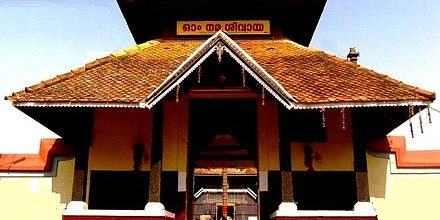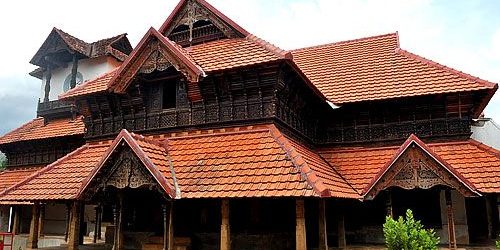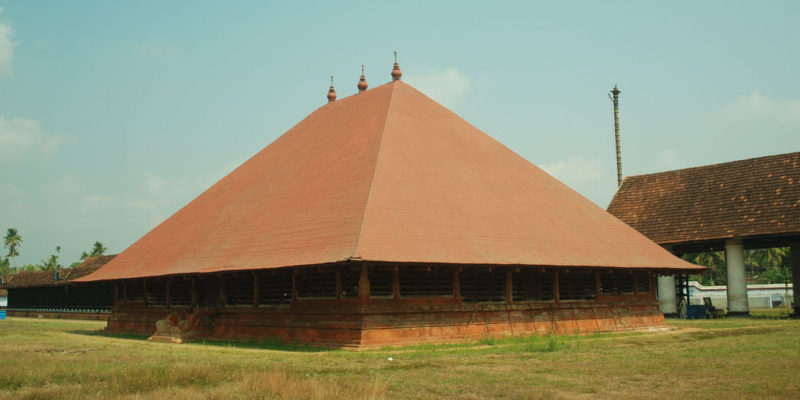Vernacular architecture is an architectural style that is designed based on local needs, availability of construction materials and reflecting local traditions. At least originally, vernacular architecture did not use formally schooled architects but relied on the design skills and tradition of local builders.
Kerala Architecture is one of the most exciting examples of preservation of vernacular styles. The evolution of the domestic architecture of Kerala followed closely the trend of development in temple architecture. The primitive models of circular, square or rectangular plain shapes with a ribbed roof evolved from functional consideration. The climate of Kerala greatly influenced traditional architecture. The natural building materials available for construction in Kerala i.e. stones, timber, clay and palm leaves have anchored and guided the acceptance or rejection of outside influences
Composition of Vernacular Kerala Architecture
The primary elements of all structures tend to remain the same. The base model is normally circular, square or rectangular plain shapes with a ribbed roof evolved from functional consideration. The most distinctive visual form of Kerala architecture is the long, steep sloping roof built to protect the house’s walls and to withstand the heavy monsoon, normally laid with tiles or thatched labyrinth of palm leaves, supported on a roof frame made of hardwood and timber. Structurally the roof frame was supported on the pillars on walls erected on a plinth raised from the ground for protection against dampness and insects in the tropical climate. Often the walls were also of timbers abundantly available in Kerala. Gable windows were evolved at the two ends to provide attic ventilation when the ceiling was incorporated for the room spaces. Most Kerala buildings appear to be low height visually, due to over-sloping of roofs, which are meant to protect walls from rains and direct sun shine. The belief system of Vastu plays a very important role in developing architecture styles. The basic underlying belief is that every structure built on earth has its own life, with a soul and personality which is shaped by its surroundings. The most important science which Kerala has developed purely indigenously is Thachu-Shastra (Science of Carpentry) as the easy availability of timber and its heavy use of it.
Materials for Vernacular Kerala Architecture
The natural building materials available for construction in Kerala are stones, timber, clay and palm leaves. Granite is a strong and durable building stone; however its availability is restricted mostly to the highlands and only marginally to other zones. Owing to this, the skill in quarrying, dressing and sculpturing of stone is scarce in Kerala. Laterite on the other hand is the most abundant stone found as outcrops in most zones. Soft laterite available at shallow depth can be easily cut, dressed and used as building blocks. It is a rare local stone which gets stronger and durable with exposure at atmospheric air. Laterite blocks may be bonded in mortars of shell lime, which have been the classic binding material used in traditional buildings. Lime mortar can be improved in strength and performance by admixtures of vegetable juices. Such enriched mortars were used for plastering or for serving as the base for mural painting and low relief work. Timber is the prime structural material abundantly available in many varieties in Kerala – from bamboo to teak. Perhaps the skilful choice of timber, accurate joinery, artful assembly and delicate carving of wood work for columns, walls and roofs frames are the unique characteristics of Kerala architecture. Clay was used in many forms – for walling, in filling the timber floors and making bricks and tiles after pugging and tempering with admixtures. Palm leaves were used effectively for thatching the roofs and for making partition walls.
Different types of Vernacular Kerala Architecture
The primary elements of all structures tend to remain the same. The base model is normally circular, square or rectangular plain shapes with a ribbed roof evolved from functional consideration. The most distinctive visual form of Kerala architecture is the long, steep sloping roof built to protect the house’s walls and to withstand the heavy monsoon, normally laid with tiles or thatched labyrinth of palm leaves, supported on a roof frame made of hardwood and timber. Structurally the roof frame was supported on the pillars on walls erected on a plinth raised from the ground for protection against dampness and insects in the tropical climate. Often the walls were also of timbers abundantly available in Kerala. Gable windows were evolved at the two ends to provide attic ventilation when the ceiling was incorporated for the room spaces. Vernacular Kerala Architecture into two parts, Nalukettu and Ettukettu
Nālukettu is the traditional homestead of Tharavadu where many generations of a matrilineal family lived. These types of buildings are typically found in the Indian state of Kerala. The traditional architecture is typically a rectangular structure where four blocks are joined together with a central courtyard open to the sky. The four halls on the sides are named Vadakkini (northern block), Padinjattini (western block), Kizhakkini (eastern block) and Thekkini (southern block). The architecture was especially catered to large families of the traditional tharavadu, to live under one roof and enjoy the commonly owned facilities of the marumakkathayam homestead.Ettukettu (eight halled with two central courtyards) or Pathinarukettu (sixteen halls with four central courtyards) are the more elaborate forms of the same architecture. Every structure faces the sunlight, and in some well designed nalukettu, there is excellent ventilation. Temperatures, even in the heat of summer, are markedly lower within the nalukettu.
Elements of Nalukettu and Ettukettu
- Padippura- It is a structure containing a door forming part of the Compound wall for the house with a tiled roof on top. It is the formal entry to the compound with the house.
- Poomukham- It is the prime portico soon after steps to the house. Traditionally it has a slope tiled roof with pillars supporting the roof.
- Chuttu veranda- In Kerala architecture, the poomukham is appended with an open passage. the chuttu verandah, which leads to either side of the house, usually surrounding it.
- Charupadi – Along the chuttu veranda and the poomukham are parapet-style, traditional carved wooden or cement benches. These are called charupadi.
- Ambal Kulam- Almost every Nalukettu has its own Kulam or Pond for bathing of its members. At the end of Chuttu verandah there used to be a small pond built with rubble on sides where lotus or Ambal used to be planted. The water bodies are maintained to synthesise energy flow inside.
- Nadumuttam A typical Nadumuttom of Kerala Nalukettu Traditional Nadumuttam or central open courtyard is the prime center of the Nalukettu. There is an open area usually square shaped in the exact middle of the house dividing the house in its four sides. Due to this four side division of the house by having a Nadumuttam.
Impact of weather on Vernacular Kerala Architecture
One of the most significant influences on vernacular architecture is the climate of the area in which the building is constructed. Buildings in cold climates invariably have high thermal mass or significant amounts of insulation. They are usually sealed to prevent heat loss, and openings such as windows tend to be small or r on-existent. Buildings in warm climates, by contrast, tend to be constructed of lighter materials and to allow significant cross-ventilation through openings in the fabric of the building.
Conclusion
The vernacular architecture is not to be confused with traditional architecture.. Traditional architecture also includes buildings that bear elements of polite design: temples and palaces, for example, which normally would not be included under the rubric of “vernacular.” In architectural terms, ‘the vernacular’ can be contrasted with ‘the polite’, which is characterized by stylistic elements of design intentionally incorporated by a professional architect for aesthetic purposes that go beyond a building’s functional requirements.
Image Source: wikiwand.com, re-thinkingthefuture.com, in.pinterest.com, en.wikipedia.org






